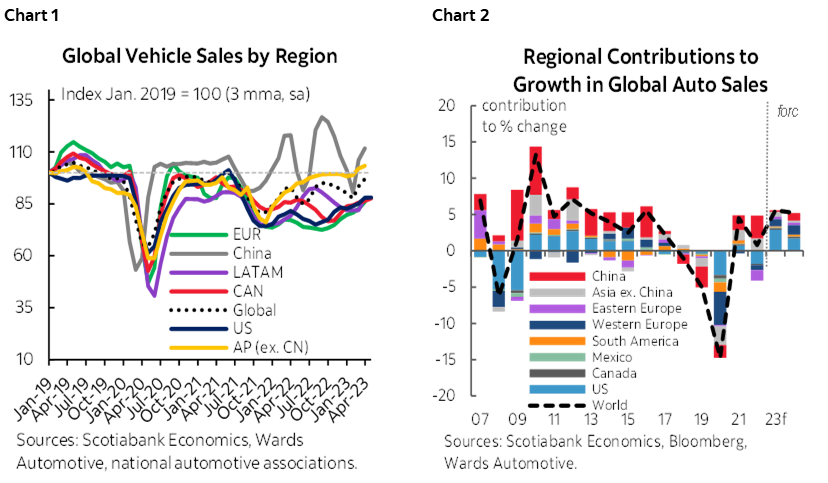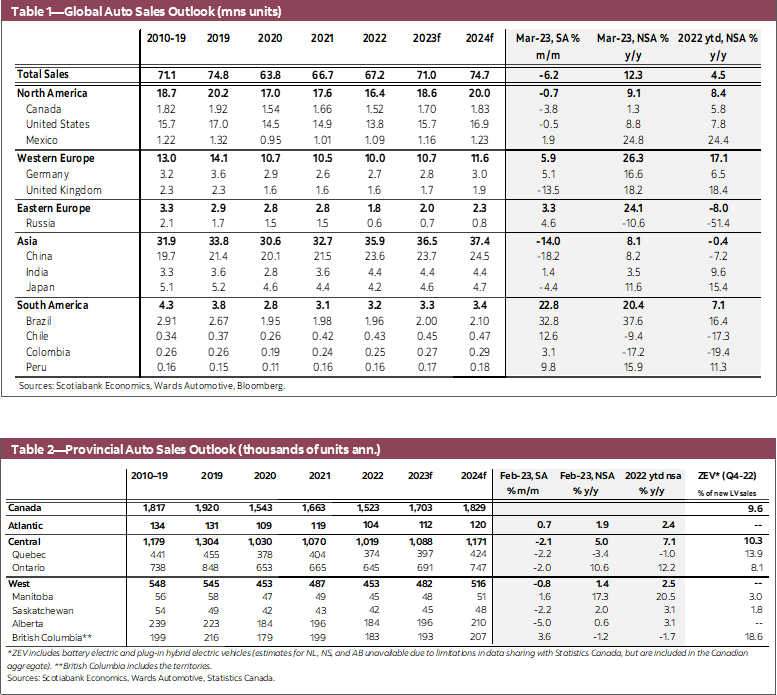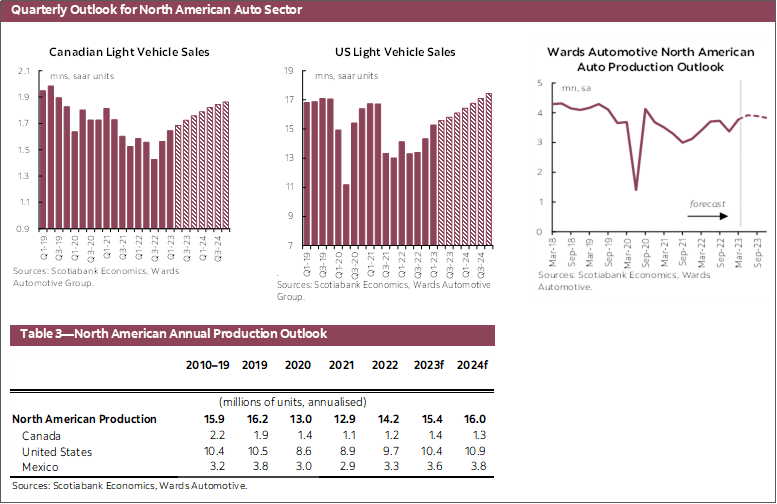CANADA: SOFT START TO SPRING
Canadian auto sales fell -1.2% m/m (sa) in April, to a pace of 1.6 mn units on a seasonally adjusted annualized rate according to Wards Automotive. Year-to-date sales in 2023 are up 3.8% compared to the same period last year but are -16.3% relative to the number of sales in the first four months of 2019. Nevertheless, April was a weak month for Canadian auto sales, as non-seasonally adjusted sales were -1.1% below sales in April 2022, and -23.2% below sales in April 2019. Canada’s tight labour market added another 41.4 k (sa) jobs in April, with the unemployment rate unchanged at 5.0% (sa) for the fifth consecutive month. While headline inflation has come down to 4.3% y/y (nsa) in March from the peak of 8.1% in June 2022, measures of core inflation annualized remains sticky above the BoC’s headline target of 2%, showing households continue to face cost pressures. North American light vehicle production slowed down to 15.4 mn (saar) units in March, rounding out Q1 with an average production rate of 15.2 mn (saar) units. The 11.9% q/q pick-up in auto production over Q4 2022 is helping alleviate some pressures from the supply side but is still below the 16.2 mn units produced in 2019. Our Canadian auto sales outlook remains unchanged for now, forecasting 1.7 mn sales in 2023, before increasing to 1.83 mn in 2024 as inflation and rates pressures ease.
UNITED STATES: CONSUMER SPENDING IS SURPRISINGLY RESILIENT
US auto sales reached 15.9 mn (saar) units in April, an increase of 7.2% (sa) relative to March sales numbers and a reversal from the two consecutive monthly seasonally adjusted declines. This brings the average seasonally adjusted annual sales rate up to 15.4 mn in 2023, a continued improvement from the 13.8 mn annual light vehicles sales in 2022, but still -9% below the nearly 17 mn units sold in 2019. April’s sales numbers were 1.5% above April 2019 levels, marking the first time since April 2021 that non-seasonally adjusted sales in a given month were greater than the respective reference period in 2019. While GDP growth slowed to 1.1% q/q (saar) in 2023 Q1, consumer spending remains surprisingly resilient, growing 3.7% q/q (saar), with goods consumption contributing 1.5 percentage points to the headline GDP growth figure. The unemployment rate ticked down to 3.4% (sa) in April, the sixth consecutive month bouncing around 3.5% in a range of +/-0.1, and added another 253 k jobs. The 48-month new car loans rate increased for the fifteenth consecutive month to 6.94% in April, up nearly 3.5 ppts relative to January 2022. US light vehicle inventories increased 5.4% (sa) to 1.73 mn (sa) in April, growing in 13 of the past 14 months on a seasonally adjusted basis. Rising inventories continue to alleviate supply constraints but remain well below the 3.35 mn (sa) levels of February 2020. Our forecast for annual US auto sales remains unchanged at 15.7 mn in 2023 against signs of improving vehicle availability but continues to face uncertainty owing to tightened financial conditions following developments in the banking sector. US auto sales are expected to pick up to 16.9 mn in 2024 as inflation and rates pressures ease.
GLOBAL AUTO SALES: UNEVEN REBOUND IN Q1 AUTO SALES
Global auto sales fell 6.2% (sa) in March, averaging 71.5 mn (saar) units in Q1 of 2023, an increase of 6.6% from the average sales level in Q4 2022. In non-seasonally adjusted terms, year-to-date global auto sales are 9.5% below sales levels of the first three months in 2019. The auto sector continues to experience an uneven recovery at the regional level (chart 1). Auto sales in Western Europe were up 5.9% m/m (sa) in March, increasing on a seasonally adjusted basis in 14 of the 15 countries covered. Gains in France (8.5% m/m, sa), Germany (5.1%), Italy (12.8%), and Spain (13.7%) were partially offset by UK (-13.5%). This rounded off Q1 with an average of 11.4 mn (saar) units sold in Western Europe, up 6.7% relative to Q4 of 2022, but Q1 2023 non-seasonally adjusted sales remain -23.6% below levels of Q1 2019. Asia Pacific auto sales fell -14% m/m (sa) in March, largely weighed down by a -18.2% (sa) decline in China which was distorted by the strong sales growth in February owing to the volatile re-opening effects. Auto sales also fell in Australia (-2.4% m/m, sa), Indonesia (-8.0%), Japan (-4.4%), and South Korea (-15.8%), but were up marginally in India (1.4%). Asia Pacific averaged 36.8 mn (saar) auto sales in Q1, a 6.1% increase from Q4 2022, and at the regional level have nearly recovered to pre-pandemic levels, sitting -0.7% below non-seasonally adjust sales in Q1 2019. Latam auto sales increased 16.4% m/m (sa) in March, bringing the average sales rate to 4.4 mn (saar) in Q1 2023, up 7.4% from Q4 2022, but remains -14.4% below Q1 2019 sales in non-seasonally adjusted terms. Auto sales were up across the region, with strong monthly increases in Brazil (32.8% m/m, sa), Chile (12.6%), and Peru (9.8%), followed by more modest gains in Argentina (4.4%), Colombia (3.1%), and Mexico (1.9%). Our global outlook remains unchanged and forecasts auto sales increasing 5.6% in 2023 and 5.2% in 2024, led by North America and Europe, but is subject to uncertainty as financial conditions remain tight with elevated rates in 2023 (chart 2).

ELECTRIC VEHICLE SALES IN CANADA: 2022 WAS ANOTHER STEP TOWARDS EV SALES TARGETS
Canadians’ shift towards purchasing electric vehicles continued to gain steam in 2022. EVs accounted for nearly one in ten (9.6%) of new motor vehicle registrations in the fourth quarter and 8.2% of all vehicles purchased in Canada last year. The market still has a long way to go in meeting the Federal interim sales target of ZEVs accounting for at least 20% of new light-duty vehicle sales by 2026 and 100% by 2035, particularly in some regions. In Ontario, the largest province by vehicle sales, EVs made up 8.1% of Q4 sales and 6.5% in 2022, up from only 3.1% in 2021. In Quebec, the province with the largest rebates for eligible EV purchases, 13.9% and 12.3% of new vehicle registrations were EVs for Q4 and annual 2022 respectively, up from 8.9% in 2021. Meanwhile, the province recently announced intentions to accelerate ZEV sales mandates. BC continues to be the leader of the transition where EV sales made up 18.6% of sales in Q4 and 16.2% in 2022 (chart 3). As Canadians deal with high interest rates and still high inflation at the margins, the decision to purchase an EV over the alternative of buying a gas car which are cheaper on average or put off the purchase altogether may pose headwinds to EV sales in the near term. In addition, limited inventory and long wait times are likely also putting off some potential purchases.



DISCLAIMER
This report has been prepared by Scotiabank Economics as a resource for the clients of Scotiabank. Opinions, estimates and projections contained herein are our own as of the date hereof and are subject to change without notice. The information and opinions contained herein have been compiled or arrived at from sources believed reliable but no representation or warranty, express or implied, is made as to their accuracy or completeness. Neither Scotiabank nor any of its officers, directors, partners, employees or affiliates accepts any liability whatsoever for any direct or consequential loss arising from any use of this report or its contents.
These reports are provided to you for informational purposes only. This report is not, and is not constructed as, an offer to sell or solicitation of any offer to buy any financial instrument, nor shall this report be construed as an opinion as to whether you should enter into any swap or trading strategy involving a swap or any other transaction. The information contained in this report is not intended to be, and does not constitute, a recommendation of a swap or trading strategy involving a swap within the meaning of U.S. Commodity Futures Trading Commission Regulation 23.434 and Appendix A thereto. This material is not intended to be individually tailored to your needs or characteristics and should not be viewed as a “call to action” or suggestion that you enter into a swap or trading strategy involving a swap or any other transaction. Scotiabank may engage in transactions in a manner inconsistent with the views discussed this report and may have positions, or be in the process of acquiring or disposing of positions, referred to in this report.
Scotiabank, its affiliates and any of their respective officers, directors and employees may from time to time take positions in currencies, act as managers, co-managers or underwriters of a public offering or act as principals or agents, deal in, own or act as market makers or advisors, brokers or commercial and/or investment bankers in relation to securities or related derivatives. As a result of these actions, Scotiabank may receive remuneration. All Scotiabank products and services are subject to the terms of applicable agreements and local regulations. Officers, directors and employees of Scotiabank and its affiliates may serve as directors of corporations.
Any securities discussed in this report may not be suitable for all investors. Scotiabank recommends that investors independently evaluate any issuer and security discussed in this report, and consult with any advisors they deem necessary prior to making any investment.
This report and all information, opinions and conclusions contained in it are protected by copyright. This information may not be reproduced without the prior express written consent of Scotiabank.
™ Trademark of The Bank of Nova Scotia. Used under license, where applicable.
Scotiabank, together with “Global Banking and Markets”, is a marketing name for the global corporate and investment banking and capital markets businesses of The Bank of Nova Scotia and certain of its affiliates in the countries where they operate, including; Scotiabank Europe plc; Scotiabank (Ireland) Designated Activity Company; Scotiabank Inverlat S.A., Institución de Banca Múltiple, Grupo Financiero Scotiabank Inverlat, Scotia Inverlat Casa de Bolsa, S.A. de C.V., Grupo Financiero Scotiabank Inverlat, Scotia Inverlat Derivados S.A. de C.V. – all members of the Scotiabank group and authorized users of the Scotiabank mark. The Bank of Nova Scotia is incorporated in Canada with limited liability and is authorised and regulated by the Office of the Superintendent of Financial Institutions Canada. The Bank of Nova Scotia is authorized by the UK Prudential Regulation Authority and is subject to regulation by the UK Financial Conduct Authority and limited regulation by the UK Prudential Regulation Authority. Details about the extent of The Bank of Nova Scotia's regulation by the UK Prudential Regulation Authority are available from us on request. Scotiabank Europe plc is authorized by the UK Prudential Regulation Authority and regulated by the UK Financial Conduct Authority and the UK Prudential Regulation Authority.
Scotiabank Inverlat, S.A., Scotia Inverlat Casa de Bolsa, S.A. de C.V, Grupo Financiero Scotiabank Inverlat, and Scotia Inverlat Derivados, S.A. de C.V., are each authorized and regulated by the Mexican financial authorities.
Not all products and services are offered in all jurisdictions. Services described are available in jurisdictions where permitted by law.

